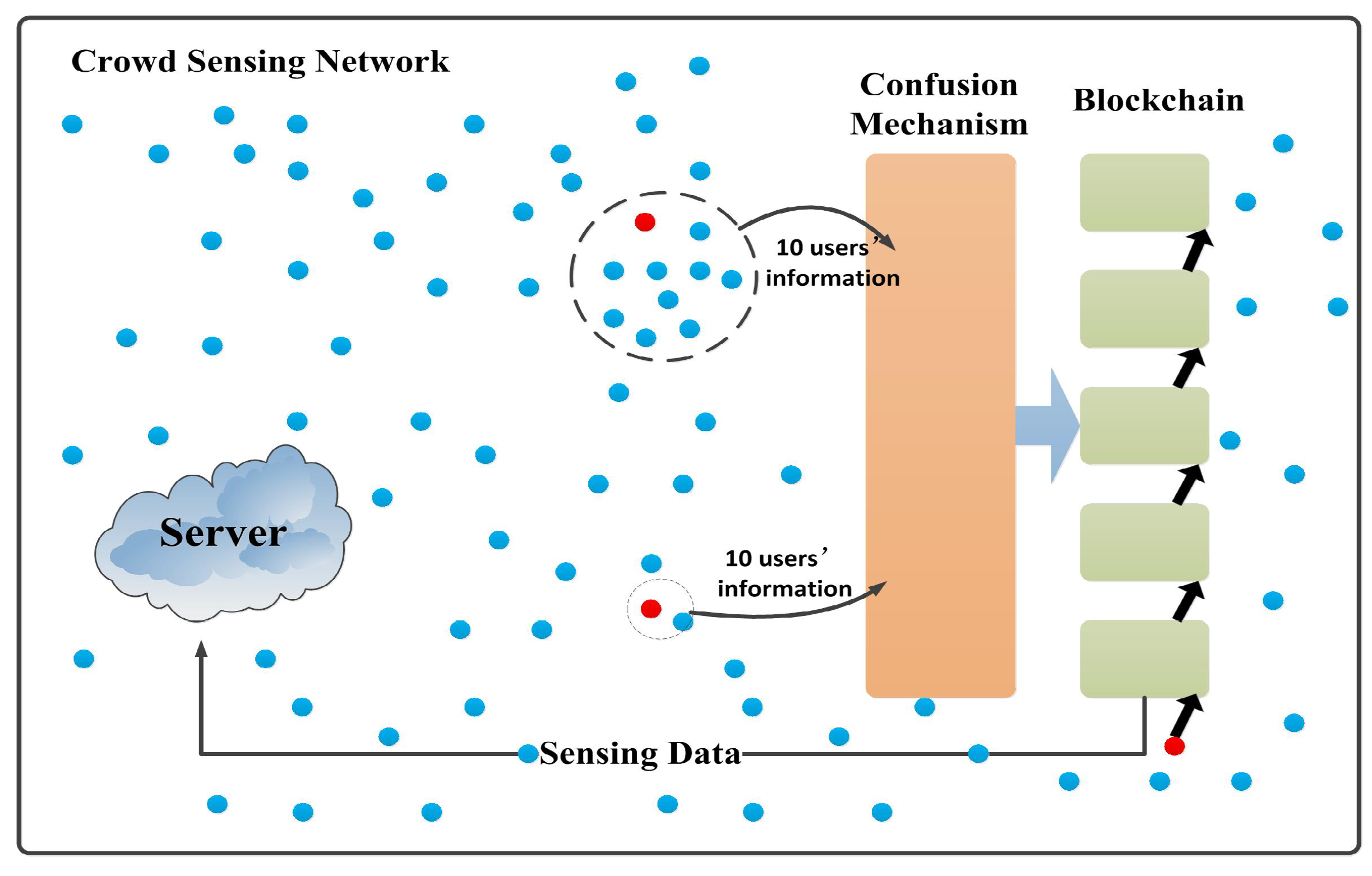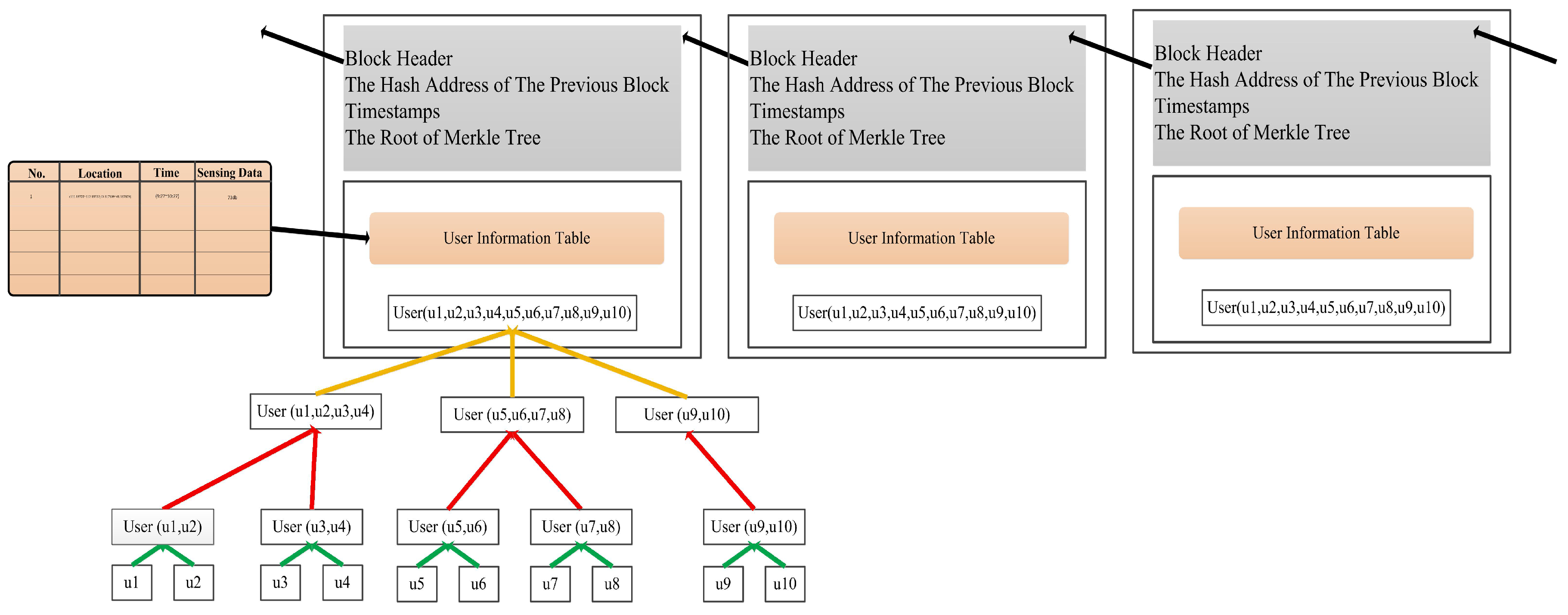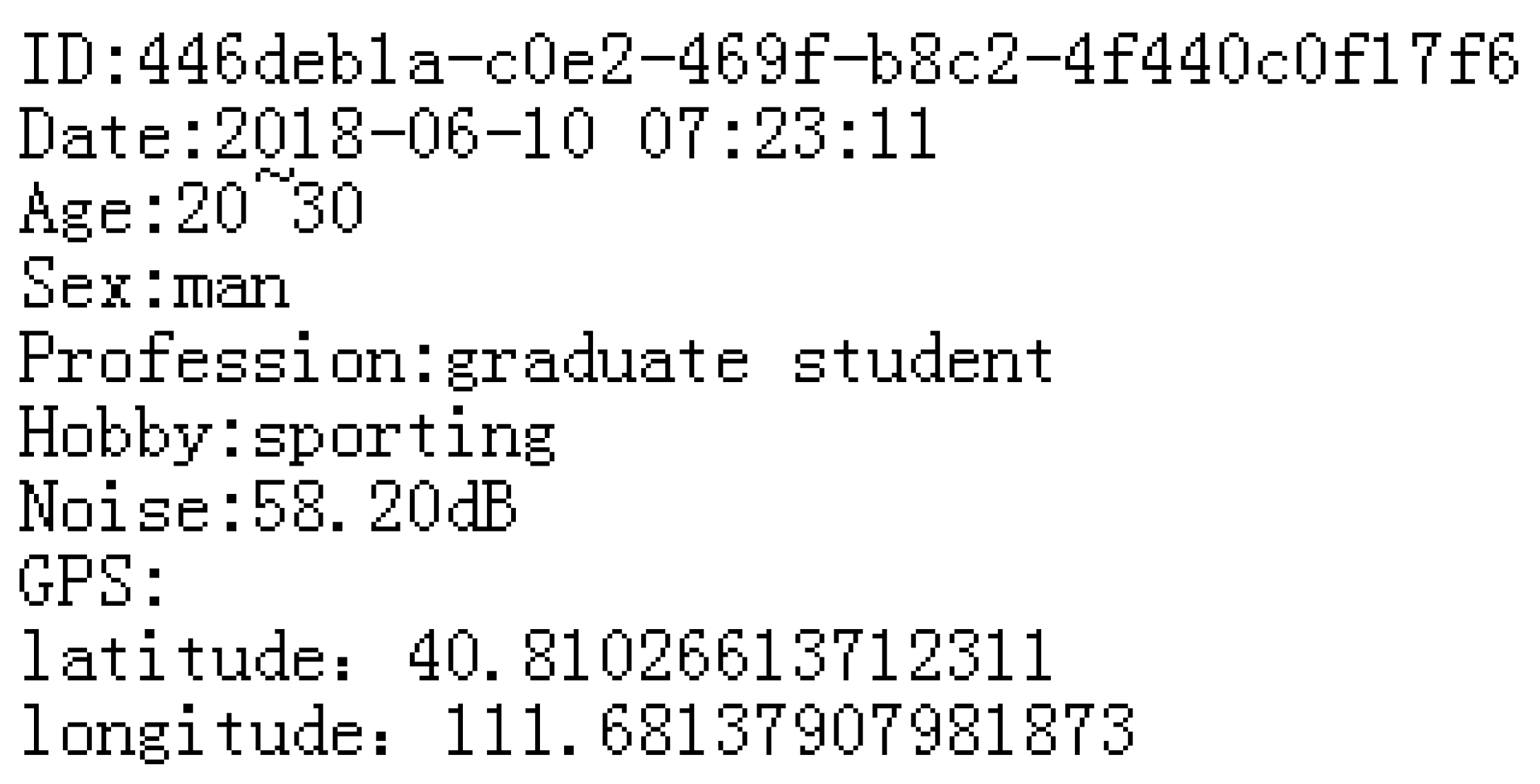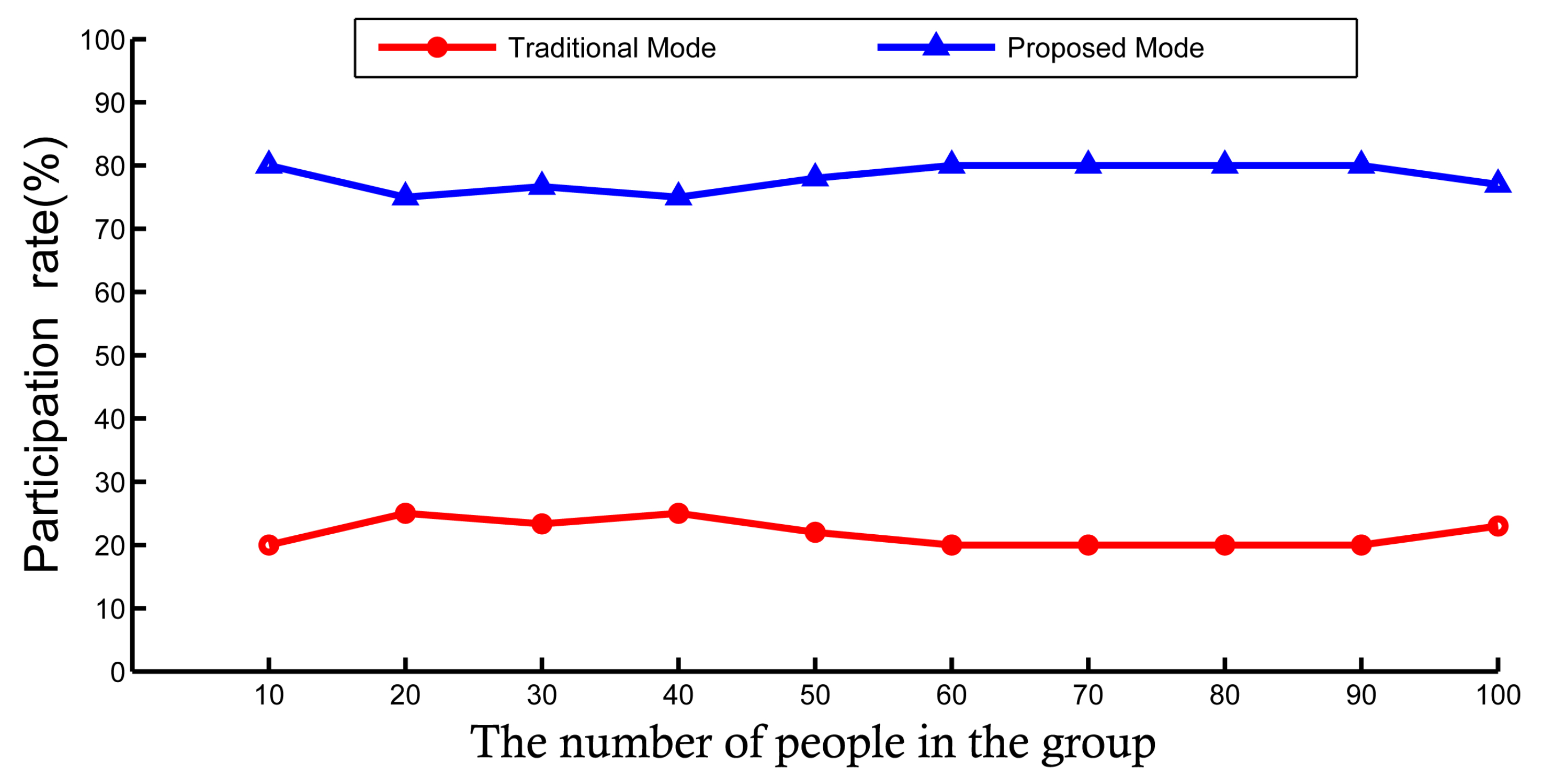A Blockchain-Based Location Privacy Protection Incentive Mechanism in Crowd Sensing Networks
Abstract
1. Introduction
2. Blockchain-Based Incentive Framework in Crowd Sensing Networks
3. Confusion Mechanism
3.1. Information Coding Definition
- Longitude coding method: Change the longitude to a 9-digit number (remove the extra part after the decimal point) and change the number to a vector . The calculation is as shown in Equations (1) and (2). Converting into a number is the encoding of longitude. Similarly, as shown in Equation (3), when decoding , simply multiply by to obtain the original vector [24,25].
- Latitude coding method: Latitude code and longitude code are the same. Change the latitude to an 8-digit number (remove the extra part after the decimal point) and change the number to a vector . The calculation is as shown in Equations (4) and (5). Converting into a number is the encoding of longitude. Similarly, as shown in Equation (6), when decoding , simply multiply by to obtain the original vector .
- Gender information coding: Gender information is relatively simple. We directly define its encoding. Male is encoded as 01 and female is encoded as 02.
3.2. Coding And Decoding Algorithm
| Algorithm 1 Confusion Mechanism Encode Algorithm (CMA-E) |
| Require: User information Ensure: Encoded user information longitude; latitude; ; ; ; Matrix P and matrix Q; if sex=man then ←01; else ←02; end if ; ; ; ; ; Combine coding information in order which as |
| Algorithm 2 Confusion Mechanism Decode Algorithm (CMA-D) |
| Require: Encoded user information Ensure: User information Split coding information in order, which as ; ; ; Matrix and matrix ; if = 01 then sex←man; else Data does not exist; end if if = 02 then sex←woman; else Data does not exist; end if , ; ; ; ; |
4. The Application of Blockchain in Crowd Sensing Networks
- Decentralization: Due to the use of distributed accounting and storage, there is no centralized hardware or management organization. The rights and obligations of any node are equal.
- Openness: The system is open. In addition to the private information of the parties to the transaction being encrypted, the data of the blockchain is open to everyone. Anyone can query the blockchain data and develop related applications through the open interface. The entire system information is highly transparent.
- Autonomy: Blockchain adopts consensus-based specifications and protocols (such as a set of transparent and transparent algorithms) to enable all nodes in the entire system to exchange data freely and securely in a trusted environment, so that the trust of "people" can be changed. Become a trust in the machine, and any human intervention does not work.
- Information cannot be tampered with: Once the information is verified and added to the blockchain, it is stored permanently. Unless more than 51% of the nodes in the system can be controlled at the same time, the modification of the database on a single node is invalid, so the data stability and reliability of the chain is extremely high.
- Anonymity: Since the exchange between nodes follows a fixed algorithm, the data interaction does not need to be trusted (the program rules in the blockchain will judge whether the activity is valid), so the counterparty does not need to open the identity to let the other party generate itself. Trust is very helpful for the accumulation of credit.
4.1. The Structure of the Merkle Tree and Motivation Strategy
| Algorithm 3 Building the Merkle Tree and Currency Allocation |
| Require: 9 encoded user information and a minner ( and miner) Ensure: Merkle tree and currency allocation repeat Continue to find new block; until miner find the new block for do end for for do end for for do if then else end if end for if is legal then for do end for else Reassemble data; end if |
4.2. User Information Table
5. Experiment and Result
5.1. Set up
5.2. Result and Analysis
6. Conclusions
Author Contributions
Funding
Acknowledgments
Conflicts of Interest
References
- Longo, A.; Zappatore, M.; Bochicchio, M.A. Collaborative learning from Mobile Crowd Sensing: A case study in electromagnetic monitoring. In Proceedings of the 2015 IEEE Global Engineering Education Conference (EDUCON), Tallinn, Estonia, 18–20 March 2015; pp. 742–750. [Google Scholar]
- Longo, A.; Zappatore, M.; Bochicchio, M.A.; Navathe, S.B. Crowd-Sourced Data Collection for Urban Monitoring via Mobile Sensors. ACM Trans. Internet Technol. 2017, 18, 1–21. [Google Scholar] [CrossRef]
- Alvear, O.; Calafate, C.; Cano, J.C.; Manzoni, P. Crowdsensing in Smart Cities: Overview, Platforms, and Environment Sensing Issues. Sensors 2018, 18, 460. [Google Scholar] [CrossRef] [PubMed]
- Corradi, A.; Foschini, L.; Gioia, L.; Ianniello, R. Leveraging Communities to Boost Participation and Data Collection in Mobile Crowd Sensing. In Proceedings of the 2016 IEEE Global Communications Conference (GLOBECOM), Washington, DC, USA, 4–8 December 2016; pp. 1–6. [Google Scholar]
- Habibzadeh, H.; Zhou, Q.; Soyata, T.; Kantarci, B. Large Scale Distributed Dedicated- and Non-Dedicated Smart City Sensing Systems. IEEE Sens. J. 2017, 17, 7649–7658. [Google Scholar] [CrossRef]
- Panichpapiboon, S.; Leakkaw, P. Traffic Density Estimation: A Mobile Sensing Approach. IEEE Commun. Mag. 2017, 55, 126–131. [Google Scholar] [CrossRef]
- Cortellazzi, J.; Foschini, L.; Rolt, C.R.D.; Corradi, A.; Neto, C.A.A.; Alperstedt, G.D. Crowdsensing and proximity services for impaired mobility. In Proceedings of the 2016 IEEE Symposium on Computers and Communication (ISCC), Messina, Italy, 27–30 June 2016; pp. 44–49. [Google Scholar]
- Knijnenburg, B.P.; Kobsa, A.; Jin, H. Dimensionality of information disclosure behavior. Int. J. Hum. Comput. Stud. 2013, 71, 1144–1162. [Google Scholar] [CrossRef]
- Li, H.; Sarathy, R.; Xu, H. Understanding Situational Online Information Disclosure as a Privacy Calculus. J. Comput. Inf. Syst. 2010, 51, 62–71. [Google Scholar]
- Wen, Y.; Shi, J.; Zhang, Q.; Tian, X.; Huang, Z.; Yu, H.; Cheng, Y.; Shen, X. Quality-Driven Auction-Based Incentive Mechanism for Mobile Crowd Sensing. IEEE Trans. Veh. Technol. 2015, 64, 4203–4214. [Google Scholar] [CrossRef]
- Guo, B.; Chen, H.; Yu, Z.; Nan, W.; Xie, X.; Zhang, D.; Zhou, X. TaskMe: Toward a Dynamic and Quality-Enhanced Incentive Mechanism for Mobile Crowd Sensing. Int. J. Hum. Comput. Stud. 2016. [Google Scholar] [CrossRef]
- Guo, B.; Nan, W.; Yu, Z.; Xie, X.; Chen, H.; Zhou, X. TaskMe: A cross-community, quality-enhanced incentive mechanism for mobile crowd sensing. In Proceedings of the 2015 ACM International Joint Conference on Pervasive and Ubiquitous Computing, Osaka, Japan, 7 September 2015; pp. 49–52. [Google Scholar]
- Zhang, Y.; Gu, Y.; Liu, L.; Pan, M.; Dawy, Z.; Han, Z. Incentive mechanism in crowdsourcing with moral hazard. In Proceedings of the 2015 IEEE Wireless Communications and Networking Conference (WCNC), New Orleans, LA, USA, 9–12 March 2015; pp. 2085–2090. [Google Scholar]
- Sun, J. Behavior-Based online Incentive Mechanism for Crowd Sensing with Budget Constraints. arXiv 2013, arXiv:1310.5485. [Google Scholar]
- Kosba, A.; Miller, A.; Shi, E.; Wen, Z.; Papamanthou, C. Hawk: The Blockchain Model of Cryptography and Privacy-Preserving Smart Contracts. In Proceedings of the 2016 IEEE Symposium on Security and Privacy (SP) (2016), San Jose, CA, USA, 22–26 May 2016; pp. 839–858. [Google Scholar]
- Swan, M. Blockchain: Blueprint for a New Economy; O’Reilly Media, Inc.: Sebastopol, CA, USA, 2015. [Google Scholar]
- Chatzopoulos, D.; Gujar, S.; Faltings, B.; Hui, P. Privacy Preserving and Cost Optimal Mobile Crowdsensing using Smart Contracts on Blockchain. arXiv 2018, arXiv:1808.04056. [Google Scholar]
- Christidis, K.; Devetsikiotis, M. Blockchains and Smart Contracts for the Internet of Things. IEEE Access 2016, 4, 2292–2303. [Google Scholar] [CrossRef]
- Meyerson, A.; Williams, R. On the complexity of optimal K-anonymity. In Proceedings of the twenty-third ACM SIGMOD-SIGACT-SIGART symposium on Principles of database systems, Paris, France, 13–18 June 2004; pp. 223–228. [Google Scholar]
- Li, J.; Huang, X.; Li, J.; Chen, X.; Xiang, Y. Securely Outsourcing Attribute-Based Encryption with Checkability. IEEE Trans. Parallel Distrib. Syst. 2014, 25, 2201–2210. [Google Scholar] [CrossRef]
- Wang, J.; Ren, P.; Zhenqiang, W.U.; Yanping, L.I. Anonymous communication mechanism based on coding-confusion. Comput. Eng. Appl. 2014. [Google Scholar]
- Liu, Z.; Li, T.; Li, P.; Jia, C.; Li, J. Verifiable searchable encryption with aggregate keys for data sharing system. Future Gener. Comput. Syst. 2017, 78. [Google Scholar] [CrossRef]
- Li, T.; Chen, W.; Tang, Y.; Yan, H. A Homomorphic Network Coding Signature Scheme for Multiple Sources and its Application in IoT. Secur. Commun. Netw. 2018. [Google Scholar] [CrossRef]
- Kumar, M.K.; Azam, S.M.; Rasool, S. Efficient Digital Encryption Algorithm Based on Matrix Scrambling Technique. Int. J. Netw. Secur. Appl. 2010, 2. [Google Scholar]
- Obimbo, C.; Salami, B. A Parallel Algorithm for determining the inverse of a matrix for use in blockcipher encryption/decryption. J. Supercomput. 2007, 39, 113–130. [Google Scholar] [CrossRef]
- Merkle, R.C. A Digital Signature Based on a Conventional Encryption Function. In Proceedings of the Theory and Applications of Cryptographic Techniques on Advances in Cryptology, London, UK, 16–20 August 1987; Springer: Berlin/Heidelberg, Germany, 1987; pp. 369–378. [Google Scholar]
- Liang, X.U.; Tong, W.Q. Image Scrambling Algorithm based on Affine Cipher and Stream Cipher. Mod. Comput. 2006, 48, 099101. [Google Scholar]
- Wahyuni, D. The Research Design Maze: Understanding Paradigms, Cases, Methods and Methodologies. J. Appl. Mang. Acc. Res. 2012, 10, 69–80. [Google Scholar]
- Peng, T.; Liu, Q.; Meng, D.; Wang, G. Collaborative Trajectory Privacy Preserving Scheme in Location-based Services. Inf. Sci. An Int. J. 2017, 387, 165–179. [Google Scholar] [CrossRef]
- Buchmann, J.; Dahmen, E.; Schneider, M. Post-Quantum Cryptography. In Proceedings of the Second International Workshop, PQCrypto 2008, Cincinnati, OH, USA, 17–19 October 2008; pp. 63–78. [Google Scholar]
- Meng, W.; Tischhauser, E.W.; Wang, Q.; Wang, Y.; Han, J. When Intrusion Detection Meets Blockchain Technology: A Review. IEEE Access 2018, 6, 10179–10188. [Google Scholar] [CrossRef]
- Wang, J.; Li, M.; He, Y.; Li, H.; Xiao, K.; Wang, C. A Blockchain based Privacy-Preserving Incentive Mechanism in Crowdsensing Applications. IEEE Access 2018, 6, 17545–17556. [Google Scholar] [CrossRef]
- Zhu, Y.; Zhang, Y.; Li, X.; Yan, H.; Li, J. Improved collusion-resisting secure nearest neighbor query over encrypted data in cloud. Concurr. Comp.-Pract. E 2018. [Google Scholar] [CrossRef]
- Chen, X.; Li, J.; Weng, J.; Ma, J.; Lou, W. Verifiable Computation over Large Database with Incremental Updates. IEEE Trans. Comput. 2016, 65, 3184–3195. [Google Scholar] [CrossRef]
- Khaled, R.; Lishan Ke, R. RoughDroid: Operative Scheme for Functional Android Malware Detection. Secur. Commun. Netw. 2018. [Google Scholar] [CrossRef]







| No. | Parameter | Value |
|---|---|---|
| 1 | ||
| 2 | ||
| 3 | ||
| 4 | Q | |
| 5 | P | |
| 6 | ||
| 7 | ||
| 8 | 2 | |
| 9 | 5 |
© 2018 by the authors. Licensee MDPI, Basel, Switzerland. This article is an open access article distributed under the terms and conditions of the Creative Commons Attribution (CC BY) license (http://creativecommons.org/licenses/by/4.0/).
Share and Cite
Jia, B.; Zhou, T.; Li, W.; Liu, Z.; Zhang, J. A Blockchain-Based Location Privacy Protection Incentive Mechanism in Crowd Sensing Networks. Sensors 2018, 18, 3894. https://doi.org/10.3390/s18113894
Jia B, Zhou T, Li W, Liu Z, Zhang J. A Blockchain-Based Location Privacy Protection Incentive Mechanism in Crowd Sensing Networks. Sensors. 2018; 18(11):3894. https://doi.org/10.3390/s18113894
Chicago/Turabian StyleJia, Bing, Tao Zhou, Wuyungerile Li, Zhenchang Liu, and Jiantao Zhang. 2018. "A Blockchain-Based Location Privacy Protection Incentive Mechanism in Crowd Sensing Networks" Sensors 18, no. 11: 3894. https://doi.org/10.3390/s18113894
APA StyleJia, B., Zhou, T., Li, W., Liu, Z., & Zhang, J. (2018). A Blockchain-Based Location Privacy Protection Incentive Mechanism in Crowd Sensing Networks. Sensors, 18(11), 3894. https://doi.org/10.3390/s18113894






